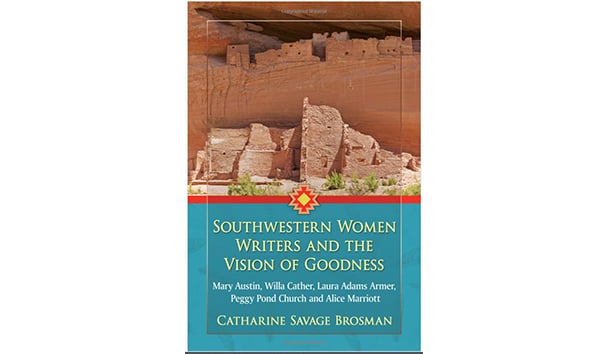Prospective readers should not be put off by the words “women writers” in the title of this book. Catharine Savage Brosman’s emphasis is not on the ideological but rather on the intellectual and artistic identity of her subjects, which complement the masculine sensibilities of their male counterparts—Walter Van Tilburg Clark, Tom Lea, John S. Van Dyke, Eugene Manlove Rhodes, Joseph Wood Krutch, Zane Grey, Edward Abbey, Charles Bowden—with their feminine ones. (Admittedly, several of these women were, to one degree or another, feminists, as was that great writer of the Nebraska plains, Mari Sandoz, best known as the author of Old Jules, whose merged affinity with her native Sandhill country in the northwest part of the state and its indigenous people, the Sioux, is comparable to that of her Southwestern sisters considered here.)
The best known of Brosman’s subjects is, of course, Willa Cather, two of whose novels—My Ántonia and Death Comes for the Archbishop—are classics of 20th-century American literature, while a third, the semiautobiographical Song of the Lark, though not so well known, presses to be another. Immediately after Cather, in terms of literary reputation, is Mary Austin, a supremely well-connected author in bicoastal literary circles and native Californian of whom it was said, alternately, that she was a genius of no talent and a talent with no genius, best known for her nonfictional work, Land of Little Rain—a resonant small volume I carried with me in paperback edition 25 years ago on my extensive travels in the areas of the Southwest that figure in the present book: the Indian country of the Navajo, Pueblo, and Hopi and the border region of the United States and Mexico. Laura Adams Armer, a painter as well as a writer, the poet Peggy Pond Church, and Alice Marriott, an ethnologist with a particular interest in the Kiowa, are far less recognizable names, whom Brosman does a distinct service by insisting upon their accomplishments. All of these women worked between about 1900 and the 1960’s, a period that produced many fine male writers of the Southwest as well.
Brosman locates these writers
in the line of American Romanticism, which dominated their cultural context and which, after flourishing in work by Henry David Thoreau and James Fenimore Cooper, remained, at least through the twentieth century and despite challenges, the default mode of American literature and culture.
Quite rightly, she disclaims any connection here with literary modernism, and postmodernism also. Romanticism suggests the myth of the noble savage and the exaltation of nature, and indeed both are elements of the work of these six women. (Armer used the term “primitive” to describe her Indian subjects, according to the anthropological terminology of the time.) Brosman associates them with “naturism” and “natural religion” (though Cather was a convert to the Episcopal Church). Beyond projecting “their personal sense of beauty, timelessness, and simplicity” onto the deserts and plains they loved, the wilderness to which they were drawn, they possessed
a deep spiritual dimension, with sympathy for native cosmology . . . intimations of another reality, a mysterious presence, expressed in standard religious terms or, more frequently, time-honored myths, and to which point totem animals, trees, clouds, and sun. . . . With the exception of Marriott . . . these writers even tend toward what they or others call mysticism (defined for current purposes as a direct relationship with God or some other Absolute), with veins of pantheism, Platonism, and Christian belief.
Noting that her subjects anticipate the environmental and sustainability movements, she adds that they reflect the thinking of John Muir. That is certainly true. I am more struck, however, by how they anticipate that of Edward Abbey, who wrote all his books in the second half of the 20th century. Abbey was a thoroughgoing pantheist who, though he seems rather to have considered himself a mystic, wished to be buried without benefit of undertaker in the desert wilderness, there to become a bird, a tree, or a cactus. (Though not a coyote: He specified in his will that plenty of rocks should be piled on his secret illicit grave, lest he undergo that particular metamorphosis.)
The strongest impression with which Catharine Brosman’s book leaves me is how much all writers and artists of the American West have in common. I think the reason for this similarity is that the artist is psychologically a bisexual creature—not in the sense of his or her physical desires, but simply inasmuch as art is at once an operation of the basic male and female principles and sensibilities, potency and activity being almost supernaturally fused with receptivity and gestation. Southwestern Women Writers succeeds in supplementing, enhancing, and completing our understanding of American letters as literature has been practiced for a century and more beyond the pale that, for Northeastern writers, has always been the Mississippi River.
[Southwestern Women Writers and the Vision of Goodness: Mary Austin, Willa Cather, Laura Adams Mercer, Peggy Pond Church, and Alice Marriott, by Catharine Savage Brosman (Jefferson, NC: McFarland & Co.) 226 pp., $39.95]

Leave a Reply